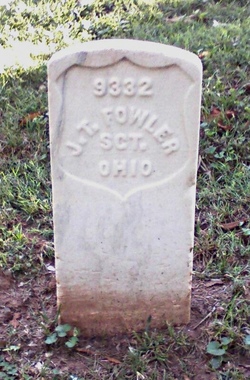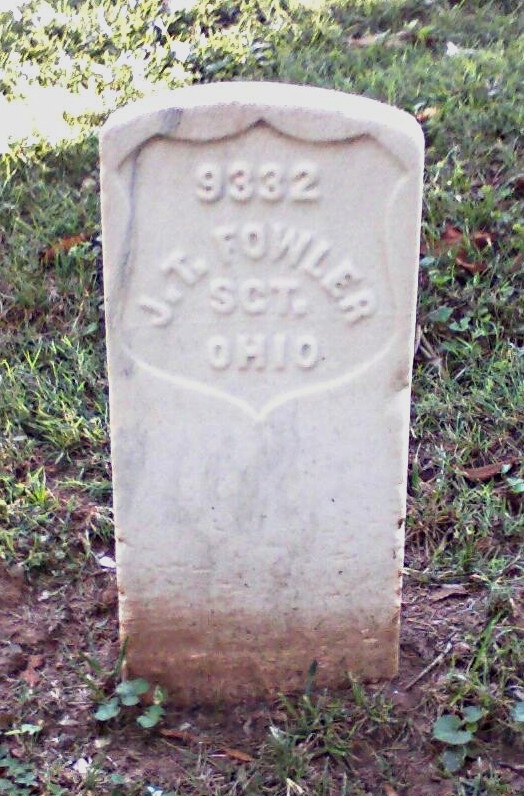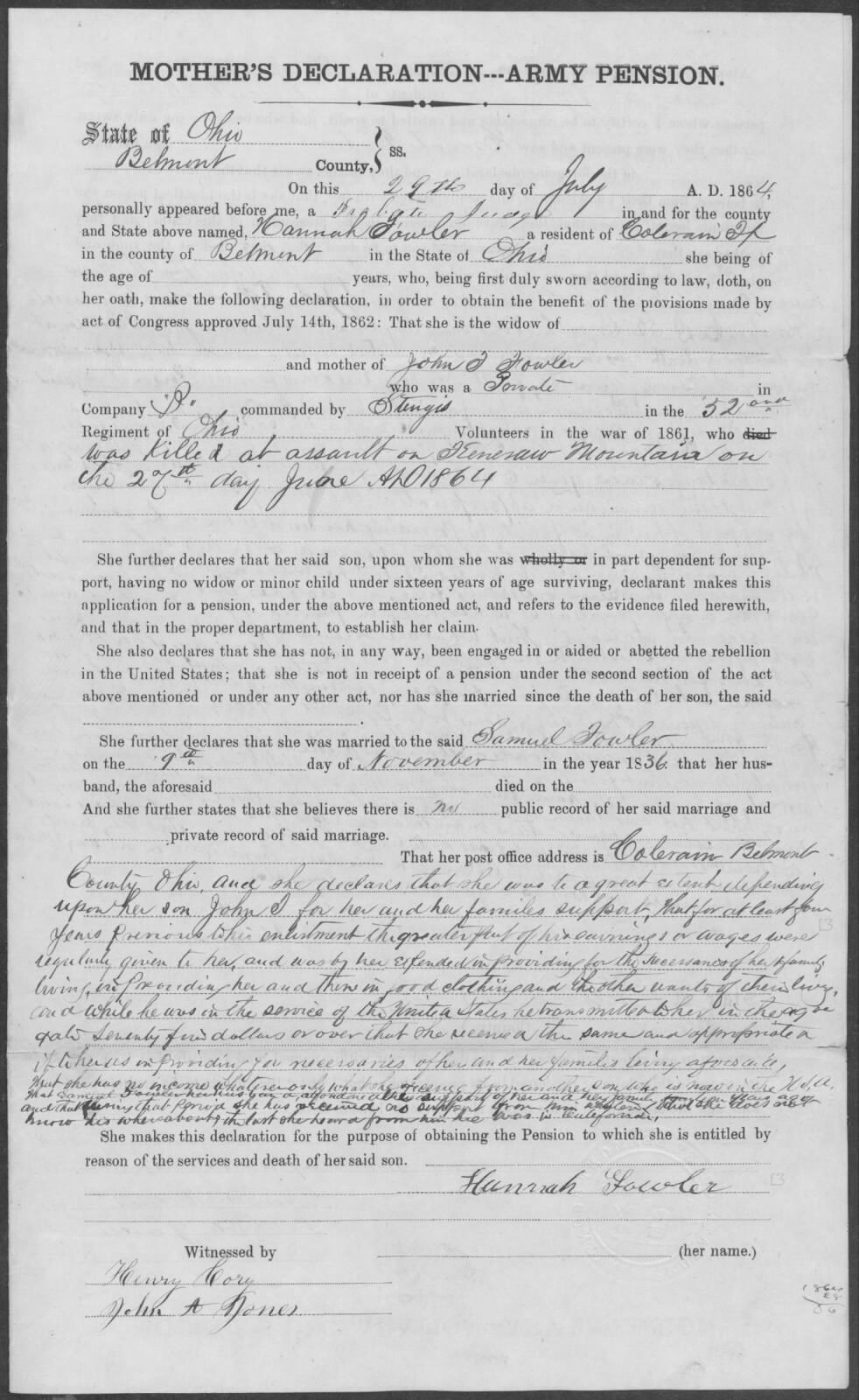Death cometh soon or late.
And how can man die better,
Than facing fearful odds
For the ashes of his fathers,
And the temples of his gods.”
Lays of Ancient Rome, Thomas Macaulay
__________________________________________
John T. Fowler of Belmont County Ohio, is the son of Samuel and Hannah (Williams) Fowler and a veteran of the Union Army in the Civil War. A Sergeant in Company B, of the 52nd Regiment Ohio Volunteer Infantry, he was killed in combat during the Union assault on Cheatham’s Hill at the battle of Kennesaw Mountain, Georgia, on the early morning of June 27, 1864. Buried on the field in the days after the battle, Sergeant Fowler’s remains, along with 342 of his comrades, were disinterred in the fall of 1866 and reburied in the new Marietta National Cemetery in Georgia.
John is referenced in Sergeant Nixon Stewart’s history of the Regiment, “Dan McCook’s Regiment, 52nd O.V.I.,” published in 1900. Stewart described the Kennesaw assault in grim terms:
“When the rough slopes of Kennesaw Mountain were reached in June 1864 the 52nd met the grim face of war head on. In a desperate uphill assault against entrenched Confederates on June 27 at what became known as the ‘Dead Angle,’ McCook’s brigade was repulsed, losing 35 percent of its strength. More than 135 Buckeyes were shot down, 45 of them killed or mortally wounded, including McCook. A member of the 52nd described Kennesaw as ‘our golgatha and our Waterloo.’ The Regiment’s major, J. Taylor Holmes, wrote soon afterward: ‘Men gave up their lives everywhere, it seemed. You could not say or think who would die or be maimed the next instant … No Ohio regiment has made a bloodier mark during the past four months.’”
Sergeant Fowler was one of the first to fall that morning. His death is described in detail:
“We moved promptly on signal, going in quick time, then double-quick, on coming to the creek, which was marshy and sluggish, our lines was somewhat broken. Firing began immediately. From the crest both musketry and artillery, but we pushed on capturing the line of rifle pits, taking the men prisoners. The batteries opened right and left, as we pushed up the hill. It is dreadful to think about. Grape and canister, shot and shell sowed the ground with rugged iron and garnished it with the dead. The first to fall was Sergeant John T. Fowler, of Co. B. As he fell, his tongue protruded from his mouth, caused by a contraction of the muscles of the throat. I longed to take him in my arms and minister to his sufferings, but we were to push the battle. The race of flags grew every moment more terrible. Four color-bearers were either killed or wounded. Linley H. Street, a brave boy, beloved by his comrades, fell, pierced to death. Sergeant Wm. J. Bradfield snatches the flag and is wounded in the strong right arm as he leads the charging column. Poor boy, he goes back to Nashville to die with the dread gangrene. David U. McCullough of Co. E, seizes the old banner and is wounded in the shoulder. Thus three of our color-bearers are shot down. The line wavers like a great billow and up comes the banner again. Now it is in the hands of James Lynne of Co. C. He losses an arm and on we go…”
At 22 years of age, James joined the service in Belmont County on August 6, 1862, for a term of three years. He was mustered into service at Camp Dennison, Ohio a few weeks later on August 21. Upon receiving news of his death, John’s mother Hannah successfully applied for a federal pension, having no other means of support. Pension records show that she died in 1901. At this writing, the resting places of Samuel and Hannah (married November 9, 1836) are not known.
John was not married at his death and had no children.
______________________________________________
Contributor: James Anderson (47575484)
Death cometh soon or late.
And how can man die better,
Than facing fearful odds
For the ashes of his fathers,
And the temples of his gods.”
Lays of Ancient Rome, Thomas Macaulay
__________________________________________
John T. Fowler of Belmont County Ohio, is the son of Samuel and Hannah (Williams) Fowler and a veteran of the Union Army in the Civil War. A Sergeant in Company B, of the 52nd Regiment Ohio Volunteer Infantry, he was killed in combat during the Union assault on Cheatham’s Hill at the battle of Kennesaw Mountain, Georgia, on the early morning of June 27, 1864. Buried on the field in the days after the battle, Sergeant Fowler’s remains, along with 342 of his comrades, were disinterred in the fall of 1866 and reburied in the new Marietta National Cemetery in Georgia.
John is referenced in Sergeant Nixon Stewart’s history of the Regiment, “Dan McCook’s Regiment, 52nd O.V.I.,” published in 1900. Stewart described the Kennesaw assault in grim terms:
“When the rough slopes of Kennesaw Mountain were reached in June 1864 the 52nd met the grim face of war head on. In a desperate uphill assault against entrenched Confederates on June 27 at what became known as the ‘Dead Angle,’ McCook’s brigade was repulsed, losing 35 percent of its strength. More than 135 Buckeyes were shot down, 45 of them killed or mortally wounded, including McCook. A member of the 52nd described Kennesaw as ‘our golgatha and our Waterloo.’ The Regiment’s major, J. Taylor Holmes, wrote soon afterward: ‘Men gave up their lives everywhere, it seemed. You could not say or think who would die or be maimed the next instant … No Ohio regiment has made a bloodier mark during the past four months.’”
Sergeant Fowler was one of the first to fall that morning. His death is described in detail:
“We moved promptly on signal, going in quick time, then double-quick, on coming to the creek, which was marshy and sluggish, our lines was somewhat broken. Firing began immediately. From the crest both musketry and artillery, but we pushed on capturing the line of rifle pits, taking the men prisoners. The batteries opened right and left, as we pushed up the hill. It is dreadful to think about. Grape and canister, shot and shell sowed the ground with rugged iron and garnished it with the dead. The first to fall was Sergeant John T. Fowler, of Co. B. As he fell, his tongue protruded from his mouth, caused by a contraction of the muscles of the throat. I longed to take him in my arms and minister to his sufferings, but we were to push the battle. The race of flags grew every moment more terrible. Four color-bearers were either killed or wounded. Linley H. Street, a brave boy, beloved by his comrades, fell, pierced to death. Sergeant Wm. J. Bradfield snatches the flag and is wounded in the strong right arm as he leads the charging column. Poor boy, he goes back to Nashville to die with the dread gangrene. David U. McCullough of Co. E, seizes the old banner and is wounded in the shoulder. Thus three of our color-bearers are shot down. The line wavers like a great billow and up comes the banner again. Now it is in the hands of James Lynne of Co. C. He losses an arm and on we go…”
At 22 years of age, James joined the service in Belmont County on August 6, 1862, for a term of three years. He was mustered into service at Camp Dennison, Ohio a few weeks later on August 21. Upon receiving news of his death, John’s mother Hannah successfully applied for a federal pension, having no other means of support. Pension records show that she died in 1901. At this writing, the resting places of Samuel and Hannah (married November 9, 1836) are not known.
John was not married at his death and had no children.
______________________________________________
Contributor: James Anderson (47575484)
Advertisement
Explore more
Sponsored by Ancestry
Advertisement



